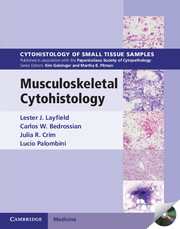Book contents
- Frontmatter
- Contents
- 1 Principles and practice for biopsy diagnosis and management of musculoskeletal lesions
- 2 Ancillary techniques useful in the evaluation and diagnosis of bone and soft tissue neoplasms
- 3 Spindle cell tumors of bone and soft tissue in infants and children
- 4 Spindle cell tumors of the musculoskeletal system characteristically occurring in adults
- 5 Giant cell tumors of the musculoskeletal system
- 6 Myxoid lesions of bone and soft tissue
- 7 Lipomatous tumors
- 8 Vascular tumors of bone and soft tissue
- 9 Pleomorphic sarcomas of bone and soft tissue
- 10 Osseous tumors of bone and soft tissue
- 11 Cartilaginous neoplasms of bone and soft tissue
- 12 Small round cell neoplasms of bone and soft tissue
- 13 Epithelioid and polygonal cell tumors of bone and soft tissue
- 14 Cystic lesions of bone and soft tissue
- Index
- References
2 - Ancillary techniques useful in the evaluation and diagnosis of bone and soft tissue neoplasms
Published online by Cambridge University Press: 05 September 2013
- Frontmatter
- Contents
- 1 Principles and practice for biopsy diagnosis and management of musculoskeletal lesions
- 2 Ancillary techniques useful in the evaluation and diagnosis of bone and soft tissue neoplasms
- 3 Spindle cell tumors of bone and soft tissue in infants and children
- 4 Spindle cell tumors of the musculoskeletal system characteristically occurring in adults
- 5 Giant cell tumors of the musculoskeletal system
- 6 Myxoid lesions of bone and soft tissue
- 7 Lipomatous tumors
- 8 Vascular tumors of bone and soft tissue
- 9 Pleomorphic sarcomas of bone and soft tissue
- 10 Osseous tumors of bone and soft tissue
- 11 Cartilaginous neoplasms of bone and soft tissue
- 12 Small round cell neoplasms of bone and soft tissue
- 13 Epithelioid and polygonal cell tumors of bone and soft tissue
- 14 Cystic lesions of bone and soft tissue
- Index
- References
Summary
INTRODUCTION
Ancillary studies including immunohistochemistry, molecular diagnostics, and cytogenetics play important roles in the diagnosis, subtyping, and prognostication of hematopoietic, epithelial, and mesenchymal neoplasms. The advent of clinically useful techniques for the detection of mutations, translocations, and copy number alterations has greatly expanded the utility of molecular diagnostics in the work-up of malignant neoplasms. Ancillary studies appear to be particularly helpful in the investigation of musculoskeletal lesions including lymphomas. Chromosomal translocations and mutations appear to be of greater diagnostic aid in bone and soft tissue lesions than in neoplasms of epithelial tissues. A subset of sarcomas bears chromosomal anomalies including reciprocal translocations, deletions, mutations, and amplifications which appear to be specific for certain histopathologic types. Mutations such as those occurring in the KIT and platelet derived growth factor alpha genes are important for the diagnosis of gastrointestinal stromal tumors as well as the prediction of response to directed therapy (Gleevec). Similarly, the SYT-SSX fusion transcript resulting from the t(X;18)(p11;q11) appears to be specific for synovial sarcoma. Of equal interest, both diagnostically and pathogenetically, are the translocations and fusion genes involving the EWS gene (22q12) which appear to define a Ewing family of sarcomas comprising the entities intra-abdominal desmoplastic small round tumor, myxoid chondrosarcoma, Ewing sarcoma, and primitive neuroectodermal tumor. These findings have facilitated the development of a molecular approach to soft tissue sarcomas. On this basis, soft tissue sarcomas currently can be divided into two groups. One group has specific chromosomal abnormalities (gene mutations and translocations) while the other shows complex often non-specific karyotypic abnormalities.
- Type
- Chapter
- Information
- Musculoskeletal Cytohistology , pp. 9 - 22Publisher: Cambridge University PressPrint publication year: 2000



